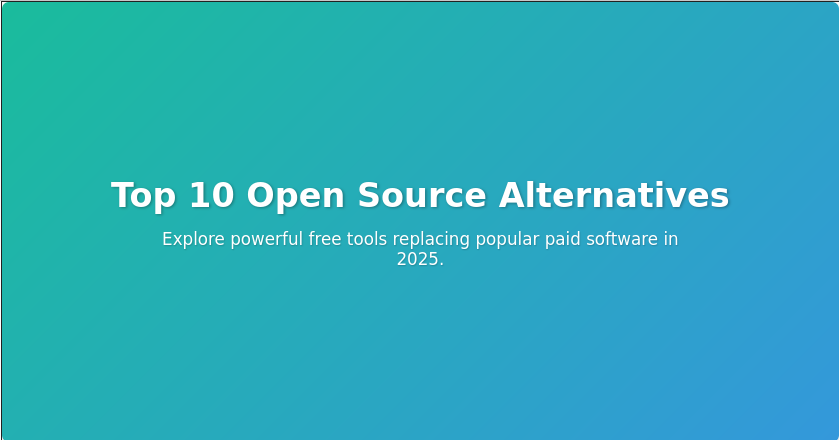10 Free Open Source Tools to Replace Paid Software in 2025
In 2025, the open-source ecosystem continues to thrive, offering powerful alternatives to expensive proprietary software. Whether you’re a student, freelancer, or business owner, these free tools can help you save money without compromising on functionality. Here’s a curated list of the top 10 open-source software alternatives to popular paid applications:

1. LibreOffice – Alternative to Microsoft Office 365
- Website: libreoffice.org
LibreOffice is a comprehensive office suite that includes Writer (word processing), Calc (spreadsheets), Impress (presentations), and more. It supports a wide range of file formats, including those used by Microsoft Office, ensuring seamless compatibility. With regular updates and a vibrant community, LibreOffice remains a top choice for those seeking a free office solution.
2. GIMP – Alternative to Adobe Photoshop
- Website: gimp.org
GIMP (GNU Image Manipulation Program) is a powerful image editor suitable for tasks ranging from photo retouching to graphic design. It offers a customizable interface, extensive plugin support, and advanced features comparable to Adobe Photoshop, making it ideal for both beginners and professionals.
3. Shotcut – Alternative to Adobe Premiere Pro
- Website: shotcut.org
Shotcut is a free, open-source video editor that supports a wide array of formats and offers a range of features, including multi-track editing, 4K resolution support, and a variety of video effects. Its intuitive interface makes it accessible for users transitioning from paid video editing software.
4. Krita – Alternative to Corel Painter
- Website: krita.org
Krita is a professional-grade painting program designed for digital artists. It boasts a vast selection of brushes, stabilizers for smooth lines, and a user-friendly interface. Krita is particularly favored by illustrators and concept artists seeking a free alternative to Corel Painter.
5. Inkscape – Alternative to Adobe Illustrator
- Website: inkscape.org
Inkscape is a vector graphics editor perfect for creating scalable designs, logos, and illustrations. It supports SVG, AI, EPS, and PDF formats, and offers a range of tools for object creation and manipulation, making it a strong contender against Adobe Illustrator.
6. VLC Media Player – Alternative to Paid Media Players
- Website: videolan.org
VLC is a versatile media player that can handle virtually any audio or video format. It offers features like subtitle synchronization, video filters, and streaming capabilities. Its lightweight nature and broad compatibility make it a favorite among users seeking a reliable media player.
7. OBS Studio – Alternative to Camtasia
- Website: obsproject.com
OBS Studio is a free and open-source software for video recording and live streaming. It offers high-performance real-time video/audio capturing and mixing, with unlimited scenes and sources. OBS is widely used by content creators and educators as a cost-effective alternative to Camtasia.
8. HomeBank – Alternative to Quicken
- Website: gethomebank.org
HomeBank is a personal finance software designed to manage your accounts, budgets, and expenses. It provides insightful charts and reports, helping users make informed financial decisions. HomeBank is a user-friendly alternative to paid finance software like Quicken.
9. ProjectLibre – Alternative to Microsoft Project
- Website: projectlibre.com
ProjectLibre is a project management software that offers features such as Gantt charts, resource allocation, and task tracking. It’s designed to be a free replacement for Microsoft Project, catering to project managers seeking a cost-effective solution.
10. Mautic – Alternative to Mailchimp
- Website: mautic.org
Mautic is an open-source marketing automation platform that enables businesses to manage campaigns, track user behavior, and personalize communications. It serves as a robust alternative to Mailchimp, offering flexibility and control over marketing strategies.
Conclusion
Embracing open-source software in 2025 not only reduces costs but also promotes flexibility, transparency, and community-driven development. The alternatives listed above demonstrate that free tools can match, and sometimes surpass, their paid counterparts in functionality and performance. Whether you’re an individual or a business, exploring these options can lead to significant benefits.